WHAT WE LEARNED ❘ By James M. Cornelius
Located in the Appalachian Mountains of northern Georgia, the Fannin County Fire Department (FCFD) is a combination fire department serving about 25,000 residents and covering nearly 392 square miles, including many rural areas. Tourism is important to the area. The FCFD has 14 stations with one class A pumper in each, a 1,000-gallon minimum tender in 12 of these stations, one 75-foot aerial apparatus, and multiple rescue and rapid-response vehicles.
- Pressler: Commercial Building Fires
- Size-Up and Risk Benefit for Small Commercial Structures
- Critical Decisions at Commercial Building Fires
- Commercial Building Fires: When To Go Defensive
Our on-duty 24-hour shift staffing consists of 10 personnel, each of whom are cross-trained firefighters/EMTs. Eight of the staff are spread out between four stations and provide advanced life support medical coverage, while the other two members are dedicated fire response personnel for the shift.
The volunteer membership accounts for an additional 75 personnel. Our EMS personnel engage in fire operations on their arrival until volunteers or other responders arrive on scene. Once personnel levels rise, they will step back into medical areas, apparatus operations, or other medical and safety team roles. If we do not have the personnel levels, a second medical unit will respond to assume those roles.
The Incident
On November 18, 2023, in the county seat of Blue Ridge, tourism was in full swing, with an estimated 50,000 to 75,000 individuals gathered in the area. At 1339 hours, the dispatch center received a report of a structure fire on a busy one-way strip downtown. The road runs through the heart of the city, where tourists travel, and the train depot is positioned for sightseeing trips through the county. These issues would cause many problems leading up to the fire incident downtown. The amount of congestion on the roadways in the area affects our response times, response routes, and ability to place apparatus and begin tactical operations quickly.
- First-Due Thoughts at Strip Mall Fires
- Back to Main Street: Five Reminders When Facing Main Street Fires, Part 1 | Part 2
Just getting home from a busy morning at the fire academy, my pager suddenly activated reporting a structure fire involving the roof at Danielle Café. Living less than a mile from the location, I responded directly to the scene in the chief’s vehicle. Turning onto East 2nd Street, I could see a large plume of black smoke above the tree line. I had thoughts of a fire involving the roof products or a fire already through the roof via the café’s grease duct because of the thick, black smoke. Arriving on the scene, I saw heavy fire had already reached a rear exterior portion of the café as well as an adjacent parked vehicle.
The Building
The building, sitting on a slight grade, is an irregular L-shaped strip mall of Type V construction, built on a concrete slab foundation. The structure was built in 1997, but over the years additional structures were added onto the original, with the lower level being added in 2003.
The entire building consisted of 15,312 square feet, which included the furniture store located in the upper section of the structure, separated by an alley. The alley between the structure was six to eight feet wide toward the upper- and lower-level areas. On the upper level, the businesses shared a common attic space that had no fire breaks installed. The roof type was a gable/dormer style with standard asphalt shingles, framed with a lightweight, truss-system roof construction.
The lower level, along West Main Street, included three businesses. The fire included a restaurant, an art store, an antique shop, and two clothing stores. The lower-level area included antiques and memorabilia. All the businesses had 10-foot ceilings and there was an interior stairwell that connected the main level to the lower level.
At the time of the incident, the structure was not protected by an automatic sprinkler system, nor did it have active, working smoke detectors. The furniture store exposure was full of high-fuel-load materials. To side C of the structure was a two-story residence separated by the rear driveway. The businesses above and around the area were farther away from the involved structure. Multiple parked cars were moved away from the area throughout to prevent involvement.
Fire Operations
Fortunately for us, the first-due engine was clearing another call just down the road and was on scene rather quickly. On their arrival, they deployed two 1.75-inch attack lines with 95-gpm combination nozzles to attempt an offensive approach. Engine 1 advanced one line to the point of origin area and the other to the front of the building. Engine 16 had one line deployed to the upper area for structural protection. Engine 12 and Tender 2 advanced two lines each for sides B and C. Engine 11 advanced two lines used for fire attack on the lower level. Engine 14 advanced two lines for fire attack on the upper front section of the structure. Since we are a combination department, I took command but was also involved in the initial attack operations due to the delay in responders arriving on scene.
At this point, we had six firefighters on scene. Engine 1 had only 1,000 gallons of water to try to stop a quickly extending fire. As we approached the seat of the fire, we saw that the fire had already extended via the overhang into the strip mall’s common attic space. The size and magnitude of the fire warranted an additional alarm, for two more station responses. The response would include two engines and two tenders responding outside the initial two stations we had paged. (This does not include our mutual-aid response.)
During our initial size-up, a 100-gallon liquefied petroleum gas tank was located adjacent to the fire area, against the building and the involved vehicle. As we began to make our fire attack, the direct flame caused the tank’s pressure-relief valve to activate.
The escaping propane ignited and caused flames to act as a blowtorch: The flames traveled up the side of the building and into the common attic of the structure. We managed to transition to protection measures for the house behind the area so we could contain the fire and prevent it from spreading. The placement of our first two lines, from Engine 1, enabled us to use fire streams to cool the propane tank. It also allowed the structure located behind the area of origin, which was beginning to show fire damage on its exterior siding, to cool.
We advanced the second line to the front of the building to make our initial attack attempt to contain the fire to the area of origin. At this point, more personnel and apparatus arrived. However, the intense fire spread throughout the attic area. The fire overtook our efforts to contain it to the single-store upper-level section. We established water supply with hydrants located at the intersections around the scene.
Slowing the Spread
When Ladder 1 arrived on scene, we began our attempt to slow the spread and protect the adjacent structures by using its aerial ladder’s master stream. Attack crews entered unaffected businesses in an effort pull ceiling to gain access for a push to contain the fire before it made the turn toward the other businesses.
Firefighters began to flow in but were still unable to have enough to make a push. There was a roof collapse in the first half of the upper-level structure within 22 minutes of the fire. That took vertical ventilation tactics away from command decisions for that section of the structure.
As the fire continued to intensify, a request for mutual aid from neighboring Union and Gilmer Counties went out, asking for aerial apparatus at the scene. While we awaited the arrival of mutual-aid ladder apparatus, we began defensive operations and attempted to stop the fire spread from approaching the lower section of the structure and contain it within the upper level. We did this by placing attack lines from Engines 14, 11, and 12 and Tender 2 (photo 1).

1. Upper side A after L1 was deployed. (Photo by Robert Poole, public information officer for Fannin County Fire Department.)
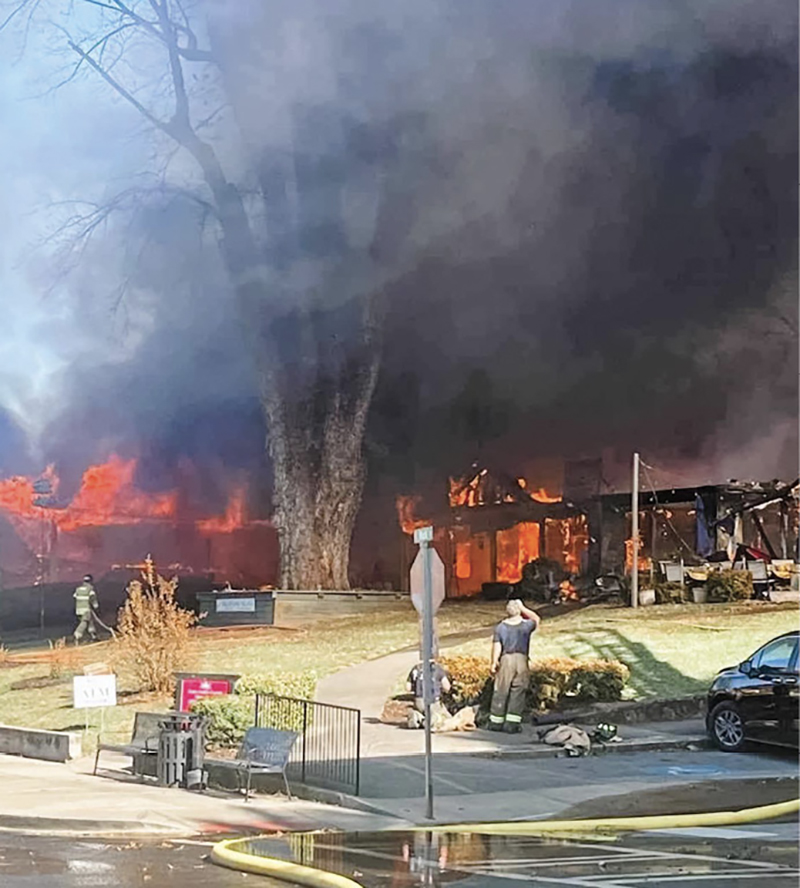
2. As we got into position in the lower level, the fire spread to the same area via the stairwell. (Photo by Jim Edelstein.)
Delegation
The engine companies and firefighters received assignments of their specific duties. Their apparatus placement dictated many of the decisions about where they would operate:
- Engine 16 was used for exposure protection from East 1st Street, above the scene.
- Engine 14 operated on the lower level with Engine 11 to set up attack angles for fire advancement.
- Engine 12 and Tanker 2 were placed on the back side of the structure to prevent fire advancement and make a push at containment until aerial apparatus mutual aid arrived.
We implemented vertical ventilation on the lower-level roof to produce a secondary fire break, in the event that conditions expanded past the stairwell. We used the stairwell fire break at the base of the structure to make our stand against the spread of fire through the structure.
Interior crews and ventilation crews stood their ground here, as fire progressed toward them. We were successful in holding the fire off, through the placement of our apparatus and personnel, until our mutual aid arrived (photo 2).
The placement of the three ladder trucks using master streams around the structure and into the large furniture store to cool and extinguish the fire proved to be the tactic that brought it under control at 1607 hours. Salvage and overhaul operations followed. Over the next few hours, our crews and mutual-aid support left the scene as they were cleaned up. Incident command was terminated at 2027 hours (photos 3-6).
Lessons Learned and Reinforced
As we looked back on the incident, we found multiple areas for improvement. We also saw many reasons our department is deserving of praise. Here’s an overview of our takeaways.
What we can do: Establishing a command post for such a large-scale incident earlier would provide incoming units with a staging point and area to obtain assignments.
What we can do: Staffing more volunteers at stations during peak times would improve response times and get personnel to the scene in a timelier manner.
What we can do: More preplanning in our department for commercial structures will help improve apparatus placement in the future to prevent missed opportunities at an aggressive attack approach. And establishing divisions for staffing the right amount of personnel will help us avoid overloading one division while another division is short on personnel.
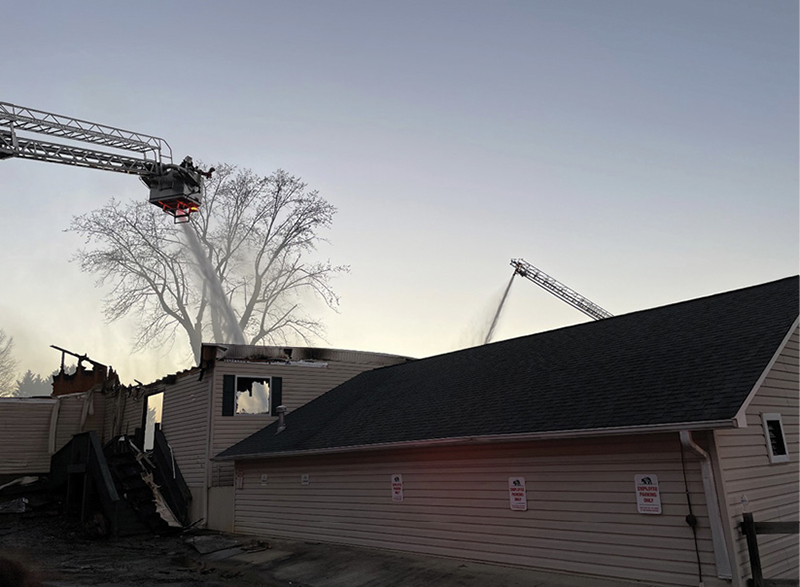
3. Lower side A ventilation location and the only fire break. (Photo courtesy of Leigh Hollins.)
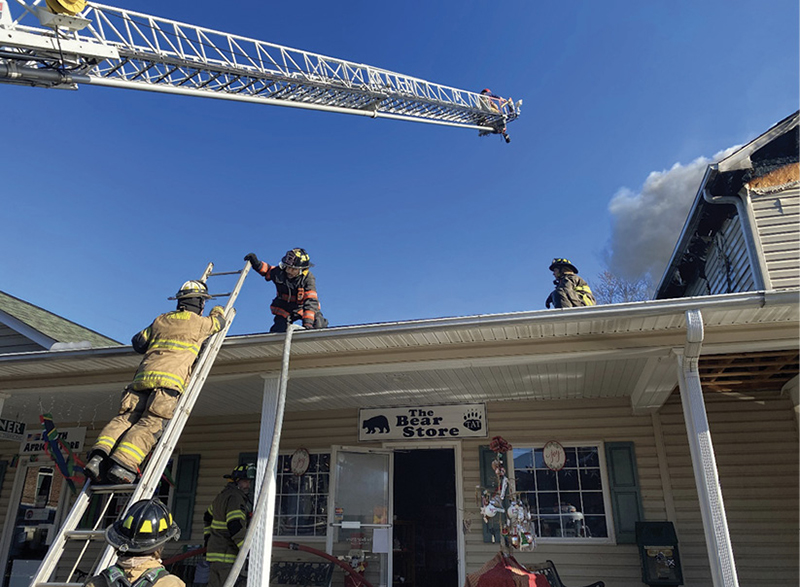
4. Stopping point from mutual aid ladder placement. (Photo by Robert Poole, public information officer for Fannin County Fire Department.)
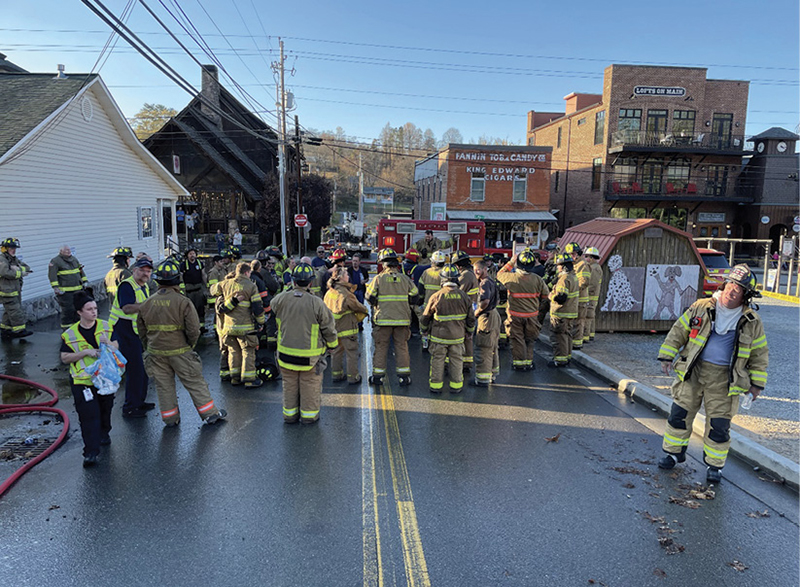
5. Command meeting with crews on scene to deliver an incident action plan. (Photo by Jim Edelstein.)
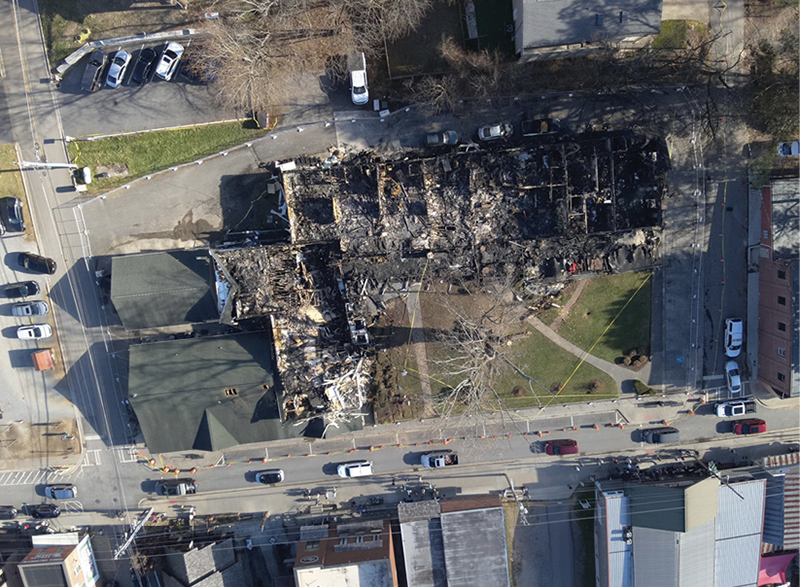
6. An overview of the scene. (Photo by author.)
Additional Takeaways
- Water supply training will be vital for us to improve on. We do not operate on hydrants at the scene of a fire often. Training more on how to catch a hydrant into a scene vs. having to connect afterward is an important takeaway from this incident.
- Having multiple apparatus flowing off the same hydrant line was challenging at first. We needed engine pump operators to provide a way to supplement the water demand and pressure for the aerial setups. (We managed to get that taken care of shortly after finding the issue, but prior setup would have eliminated a few minutes of repositioning of hoseline time.) We fixed this water supply issue during the incident by increasing our pump pressures and setting up engines and Tender 2 in a way that increased our pressures through our pump.
- Increasing our supply line size from hydrants to five inches allowed us to obtain more volume for our hydrant system.
Findings from the Investigation
The Georgia State Fire Marshal’s office conducted the investigation of this incident. They found the point of origin to be around the back of the café, on the upper section of the structure. This was around a few trash cans in the area, which ignited the exterior wall and spread to a vehicle next to the rear of the building. A 100-gallon propane tank and a refrigerant tank next to each other caused fire to enter the roof of the structure. The propane tank vented, causing rapid fire spread into the attic.
As an IC, losing six buildings was very disheartening to me. But due to the advanced fire on arrival and the involvement of the propane tank, saving four business and protecting the exposures was a win for our firefighting efforts. Working hand in hand with career and volunteer firefighters, as well as our mutual-aid units, enabled us to extinguish this multiple-alarm fire before the total destruction of the structure or extension to the exposures. As a community, we had businesses, individuals, and even off-duty firefighters helping with water, moving air bottles around, helping move hoses, and connecting hoses to hydrants. During this incident and in the time that followed, the family nature of downtown Blue Ridge’s community truly revealed itself.
JAMES M. CORNELIUS is the training chief of the Fannin County Fire Department. He is a paramedic as well as a hazmat technician. He is also a fire instructor teaching numerous classes to the combination department. Cornelius has completed technical college classwork through Tri-State Community College.

